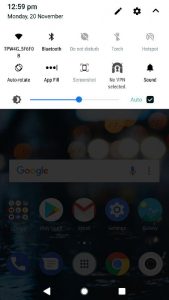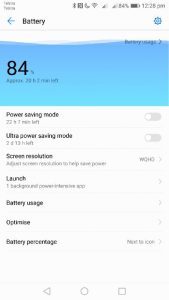Huawei is quickly becoming a dominant name in the Android game both internationally and here in Australia, in fact they are ranked the second or third smartphone manufacturer in the world (depending on the month). When I sneak a peek at what device people are using I am spotting more and more Huawei devices ‘in-hand’, and with a device like the Mate 10 leading their product line up it’s not hard to see why.
The only thing about the Mate 10 that doesn’t scream “I’m a flagship device” is the price. At $899 outright Huawei’s top of the line phone may just be the best value, top of the line, no-holds-barred premium Android phone officially sold in Australia.
Note: although Huawei do make a Mate 10 Pro that is more expensive, we are considering them to be equivalent phones as they have extremely similar hardware and features. The Mate 10 Pro has more RAM and more on-board storage but they share the same camera, processor and software.
They differ in footprint as well with one taller and thinner from an 18:9 aspect ratio display (the Mate 10 Pro) and one wider due to the more traditional 16:9 display (the Mate 10). The Pro, due to the fact it has very little room on the small front bezel has its fingerprint sensor on the rear of the phone whereas the Mate 10 somehow squeezes it onto the bottom bezel.
For this first review we will focus on the Mate 10 and follow it up next week with the Mate 10 Pro, hopefully answering some of the questions you may have at the same time. What are you getting in the Huawei Mate 10? Let’s dive in and see.
WHAT’S INSIDE?
Everything, and two of some things.
The Mate 10 is powered by Huawei’s own Kirin 970 SOC, this thing is a beast with an 8-Core big.LITTLE configuration maxing out at 2.36 GHz paired with a 12-core Mali-G72 GPU. This is supported by 4GB of RAM, 64GB of internal storage and of course a SD-card slot.
Rounding out the hardware package is a 4000 mAh battery, dual Leica rear cameras, a 5.9” 16:9 WQHD (2K) LCD display, fingerprint sensor, a headphone jack (big tick), USB-C with fast charging and all of the standard connectivity you would expect from a 2017 flagship device all packed into a sleek and elegant device.
What’s it missing? Honestly nothing (well maybe wireless charging but Qi doesn’t know if it’s coming or going these days), I couldn’t out-Android this hardware; everything I wanted it to do it just did, easily.
Check out the full specs below:
| Key Specifications: | Huawei Mate 10 |
|---|---|
| Release date | November 2017 |
| Screen size | 5.9-inch |
| Screen technology | RGBW LCD |
| Resolution | 2,560 x 1,440 |
| PPI | 499 |
| Rear camera | 20MP+12MP |
| Rear aperture | f/1.6 |
| Front camera | 8MP |
| Front aperture | f/2.0 |
| Chipset | Kirin 970 |
| Core config |
|
| RAM | 4GB |
| Storage | 64GB |
| MicroSD | Yes, up to 256GB |
| Battery | 4,000 mAh |
| Battery removable | — |
| Connector | USB C |
| Headphone Port | — |
| Headphone Location | — |
| Speaker Configuration | — |
| WIFI standards |
|
| Bluetooth standards | 4.2 |
| NFC | Yes |
| Location | — |
| Android OS | Android 8.0 |
| Vendor skin | EMUI 8.0 |
| Dimensions | 150.5mm x 77.8mm x 8.2mm |
| Weight | 186g |
| Colours | Black |
WHAT’S IT GOOD AT?
Almost everything. No device can ever be perfect but honestly the Mate 10 is just a solid performer all round. The overall build of the all glass body is spectacular, and the black model we had to review, while a little fingerprinty, was gorgeous. It’s never been harder to put a phone in a case, which, as usual, Huawei provide in the box: thanks Huawei.
The 4000 mAh battery combined with the power-efficient Kirin 970 makes the Mate 10 just run and run. On low usage days, eg days with too many meetings, I routinely got home with 80% battery. On other days with 3 hours screen on time including very taxing 3D graphic games, I’d typically still have 40%. I couldn’t run this sucker flat with normal daily use.
Moving to the 2k 5.9-inch LCD display I found the default colours a little pale compared to the Pixel XL (1st gen), however this is one place where Huawei’s software shone through: you have a lot of control over the screen colours so if you’re picky you can really tune it, and honestly it was only noticeable when using side by side. Overall the display was beautiful with an array of customisations for colour and UI elements.
I hate Bluetooth, but I hated it less on the Mate 10, in fact if the Mate 10 Bluetooth experience was the norm I may not hate it anymore. The Mate 10 never gave me any pairing issues or wonk, what’s more if you live the multiple Bluetooth device hell like me the Mate 10 is a great companion.
Unlike some devices the Mate 10 intelligently switches to a paired Bluetooth device when it comes in range. For example, when you’re listening to a podcast on your headphones and get into the car. When the car Bluetooth turns on the audio seamlessly switches over, first time, every time. At the other end power on your Bluetooth headphones again and pop, the audio jumps back over.
This combined with reliable Bluetooth and good signal range actually made Bluetooth fade into the background, something I rarely experience with any device. Android world, please do whatever Huawei did to achieve this!
The Cameras
Let’s talk cameras. The Mate 10 is packing dual rear cameras one 20MP monochrome sensor and a 12 MP RGB both sporting f/1.6 apertures with Leica lenses. Around the front is a 8 MP camera with a f/2.0 aperture.
When it comes to my smart phone camera I want something that loads quickly, catches images quickly and reliably captures clear images. In short the Mate 10 delivers on all of that and more. In late 2017 solid camera performance is table stakes, so the Mate 10 needs to deliver more than that to be competitive and I think it does.
The Mate 10 includes a Neural Processing Unit (NPU) which gives the phone on-device AI functionality. One use of this is to enhance the Mate 10 computational photography: The NPU lets the camera automatically detect the contents of the photo in real time and adjust the shooting mode on the fly to one of 13 different scenes at launch.
The dual lens setup gives the Mate 10 a few neat tricks. The Mate 10 has near lossless 2x digital zoom thanks to the two shooters and in low light situations the camera merges the data from both sensors to improve the final images.
Overall cameras are an inherently subjective thing, what one person likes another may not. What I can say is that the Mate 10 takes reliable, crisp photos. Are they tuned to your liking? Only you know that but check out a few samples below to see if it floats your boat.
Performance
While the Android world is dominated by Snapdragon they’re not the only game in town, and the Kirin 970 proves that there is strong competition in the SOC space. Honestly the performance of the Mate 10 was something I never thought of. It was consistently buttery smooth and even tougher 3D games played on full settings without a stutter. I think good performance is should be just a given at the high end now.
Dual SIM is something that if you need it can be fantastic. For the first time in 2 years I carried just one phone around, and I kind of like that. What would make the Dual SIM experience excellent is more use by use customisation. eg. for data you can only select 1 SIM, it would be useful to specify which SIM a specific app used for data, eg my work emails and cloud storage could use my work sim.
Additionally if contacts could be set to use a specific SIM by default it would simplify the dialing process which currently introduces either a second step for choosing which SIM you want to use to sometimes just defaults to SIM 1.
Overall I think I might move back to using a Dual SIM phone as standard, especially one with such excellent battery life.
WHAT’S IT LESS GOOD AT?
I have to declare I’m a stock Android guy, I like my UI to be Googley and am not a fan of any additional goodies like enhanced power management or “system cleaners”. With that in mind let’s discuss the software.
Out of the box the Mate 10 is running EMUI 8.0 built on top of Android 8.0 (so yes this should/could be a Project Treble device) with the October security patch which, considering this had review software running, is excellent.
Huawei have toned down EMUI a lot since I last played with one of their devices, however it is still not quite to my taste. However, Huawei’s theming engine is a fantastic way to instantly turn the UI 90% into stock. I found a Pixel 2 skin which when combined with Nova Launcher gives you a stock looking device. I wish other OEMs would build in theming this good into their ROMs. (editors note: be careful with the theme you use as it can adversely affect normal operation of the phone). Here’s an example of how easily you can theme in EMUI 8.0.
Unfortunately, a skin can’t get rid of things like battery usage notifications, which even if you switch to manual management decides to inform you whenever an app is doing something it doesn’t like. In the end this is more of a nuisance than a killer flaw.
One annoyance was Huawei’s implementation of the Android Screensaver function. Screensaver replaced Daydream as the system that controls what your screen does when charging and not in use. On most devices you can select what screensaver does, eg scroll through photos or show a clock. Unfortunately, EMUI only supports scrolling through photos, I miss my bedside clock.
The one major software issue I had with the Mate 10 was how Huawei handles accessibility settings. If, like me, you use a password manager then those apps currently use accessibility features to assist with managing your passwords. EMUI, for some reason tends to turn the Accessibility off for apps randomly. For users of apps such as Tasker, Greenify and LastPass it is a massive hassle having to enter settings constantly to turn it back on. This is not new to EMUI 8 as we have reported on it previously in prior Huawei reviews.
There is currently some movement in this space, with Google introducing an autofill API as well as Google looking to restrict access to accessibility features, however today that’s not the case and having to re enable Accessibility EVERY TIME you want to use a password manager may be an issue for you.
I did experience some issues with Android Auto in phone mode. However being a review ROM and Scott not experiencing this same issue on the Mate 10 Pro I think it’s not likely to be an issue for retail models.
All that said, EMUI does give you access to more controls than a stock ROM so there are benefits as well. With more customisations for some settings hiding there if you go looking, and if you don’t need them they’re not going to get in your way.
CONCLUSION
I’ve never had the opportunity to review a Huawei device and the Mate 10 makes me think I’ve been missing out. Huawei knows how to make great hardware and the Mate 10 is the embodiment of that. I’ll never know if previous devices were this good but I sure am glad the Mate 10 was my first Huawei device – based on this hardware I’m now really wanting to try a Huawei Watch 2.
Who should buy a Mate 10? Honestly anyone. Some devices are more suited to an enthusiast market, some may have great hardware but questionable software and others are just solid: the Mate 10 is solid all round. There is one caveat to this, and that’s the accessibility issue for password managers etc.
If your Mum uses a password manager, and isn’t an uber nerd, I wouldn’t recommend the Mate 10 until apps like Lastpass fully implement the Autofill API and no longer need accessibility to survive. For me I can probably handle the annoyance of the extra 3 steps every time I want to use LastPass, and if you don’t use a password manager (you should) this isn’t an issue for you.

























Thanks for the review, helped sway my decision to buy this phone after 7 years of apple. Key points for me were
6 inch screen
16:9 ratio
Big battery
Headphone jack
Android 8 Oreo
Price (value)
The battery life on this phone is terrible for its specifications.
It gets bested by phones with higher res and brighter screens with smaller batteries.
How so? Comparing to which phones? Interested to know as i’m just about to purchase it. Every article I’ve read about the Mate 10 states “awesome” battery life. They talk in days whereas most other phones require recharge in less than a day
Doesn’t the Mate 10 have a LCD panel, not an AMOLED like your article keeps referencing?
It does have an LCD. Our apologies, updated.